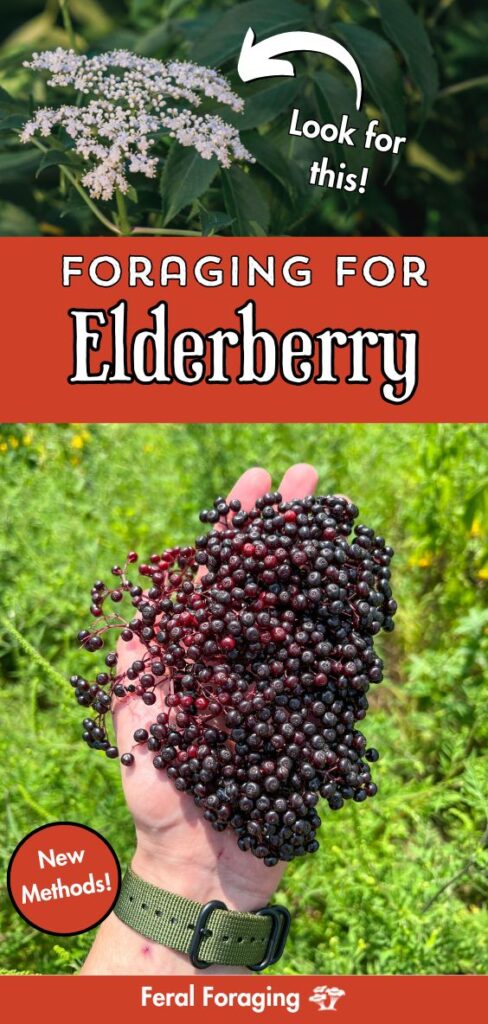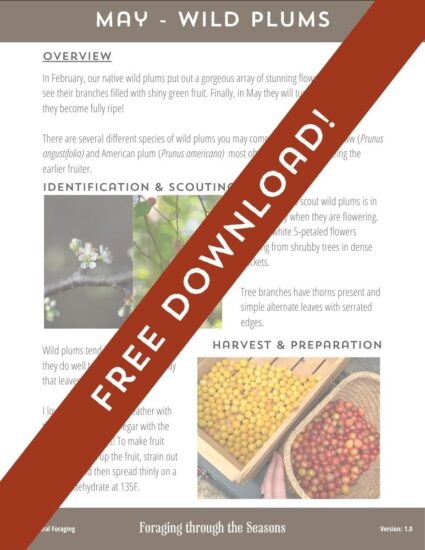Elderberry is one of the greatest wild fruits on the planet. They are growing in popularity due to their traditional medicinal uses, but they have many food uses you shouldn’t overlook!
Wild elderberries are easy to find, identify, gather, and preserve.
This is an excellent wild plant that everyone should be familiar with!
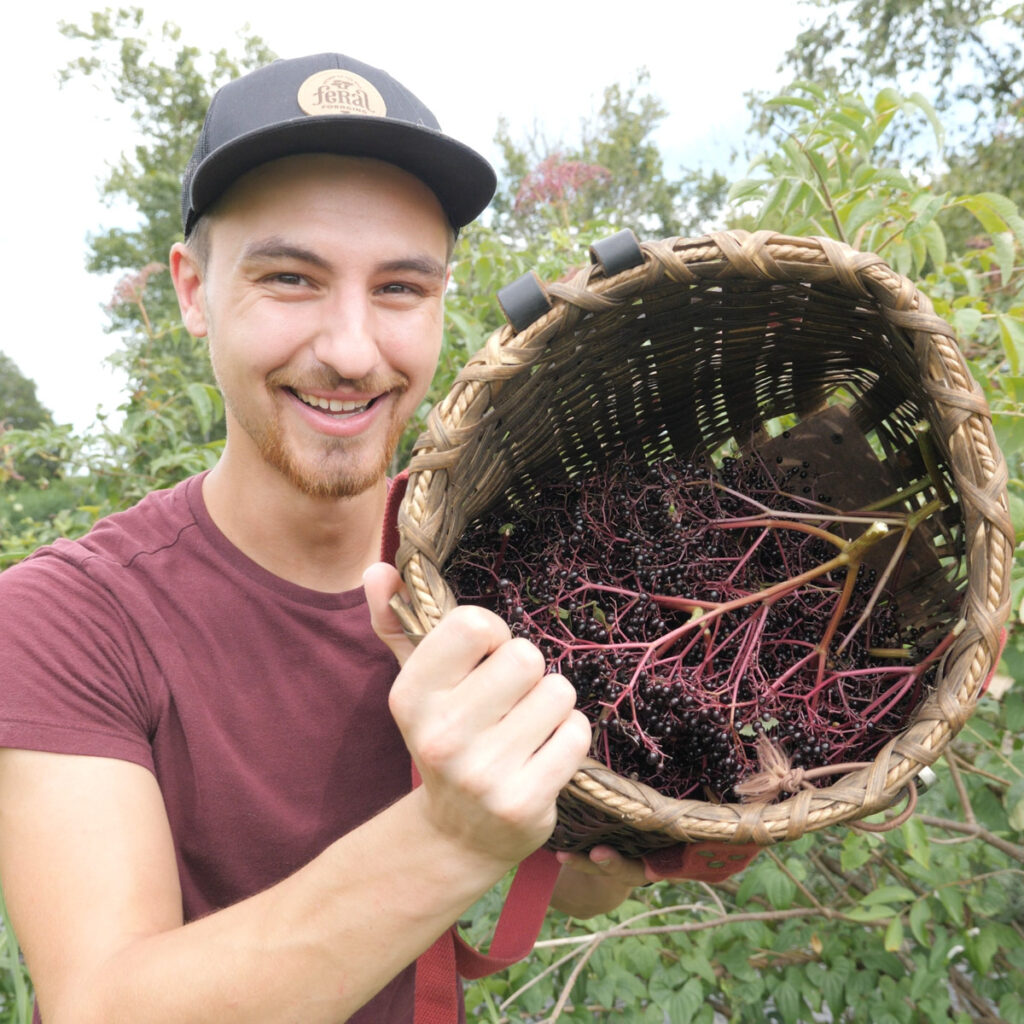
Cautions
Elderberry should not be consumed raw off the bush!
Raw elderberries cause gastrointestinal distress in many people.
Elderberries need to be cooked (or fermented) to break down the chemical compounds that some people react negatively to.
This is discussed further in the Toxicity section below.
In my opinion, raw elderberries are culinarily inferior to their cooked counterparts, so this isn’t something I worry about anyway!
Further, the only parts of elderberry that can be consumed are the flowers and the berries, not the leaves or vegetative parts!
How to find elderberry
Wild elderberries are very easy to find if you know where AND when to look for them.
Don’t make the mistake of looking for elderberries (and other wild fruit, for that matter) in the woods. They will not fruit vigorously there!
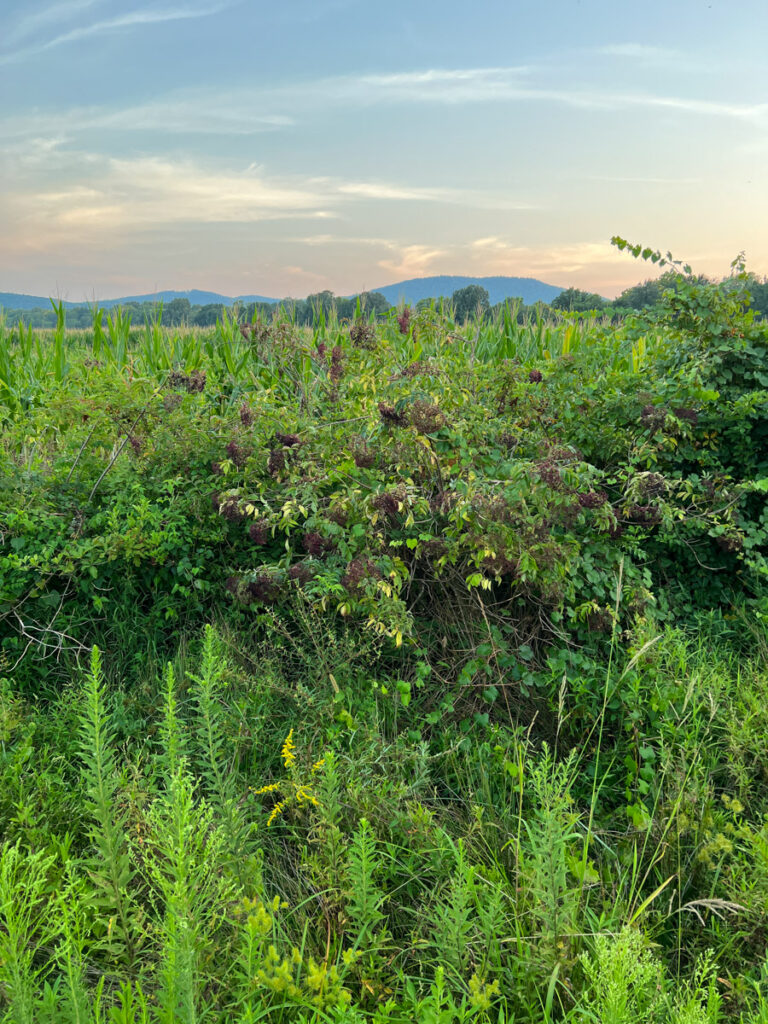
Where to look
You can find elderberry plants in a wide array of areas. However, elderberries fruit more vigorously in open, wet areas!
Creeksides, ditches, and boggy forest edges are all ideal habitats for elderberry.
In addition to them fruiting better in these locations, this also means there will be more fruit left for you, as heavier berry clusters that droop downwards are more difficult for birds to get than lighter clusters.
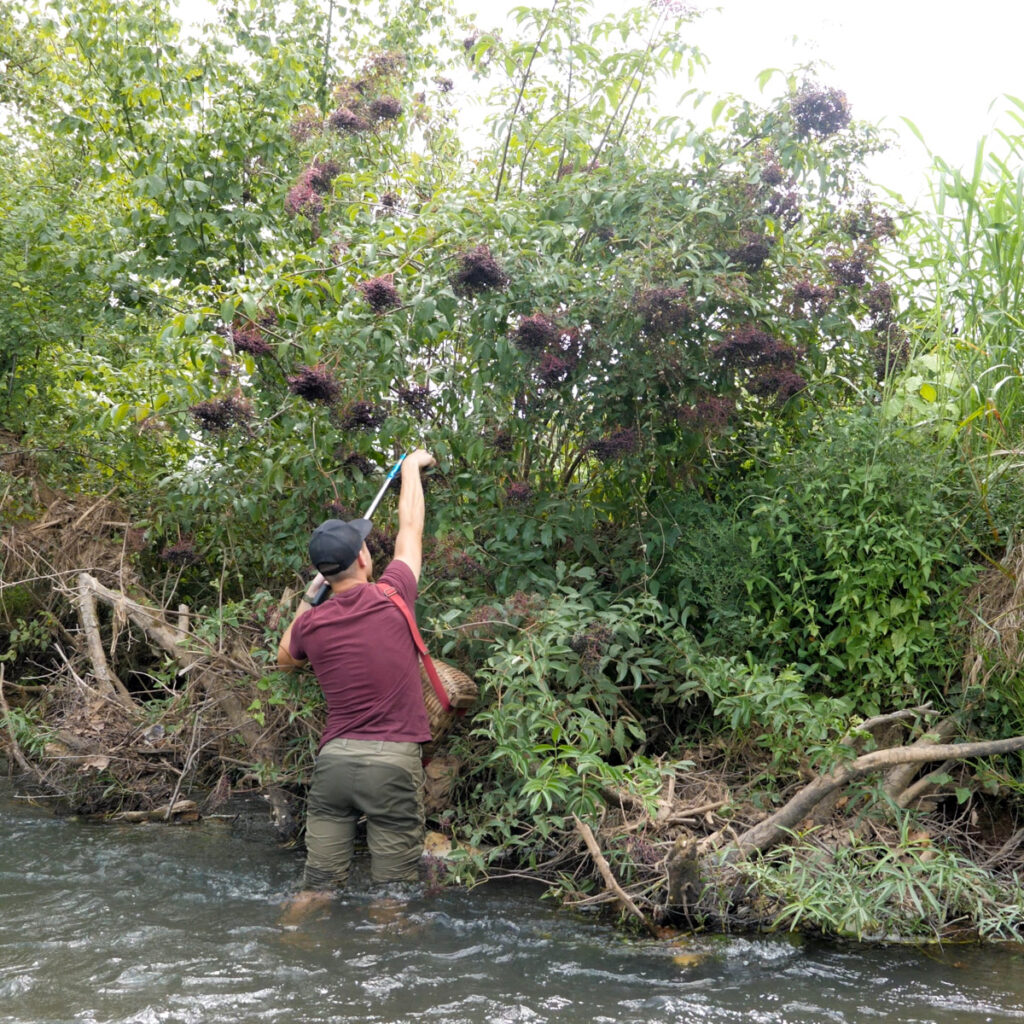
When to look (when they are flowering)
The BEST time to find elderberry is during their flowering window because the large bright white blooms of elderberry are extremely easy to spot even from a long distance away!
Elderberry typically flowers in late spring to early summer; the fruit is usually ripe in late summer.
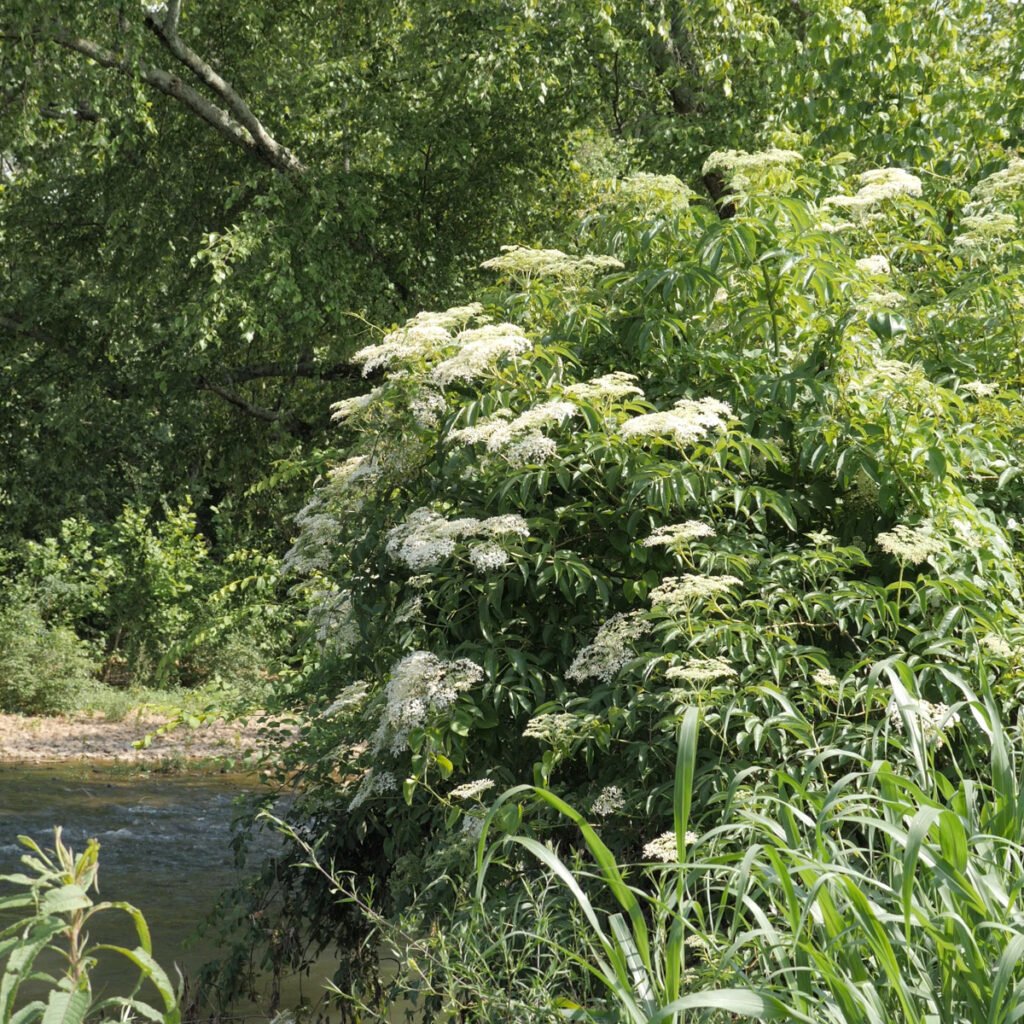
You can find more detailed timing for all parts of elderberry and dozens of other wild fruits in my Interactive Forager’s Calendar!
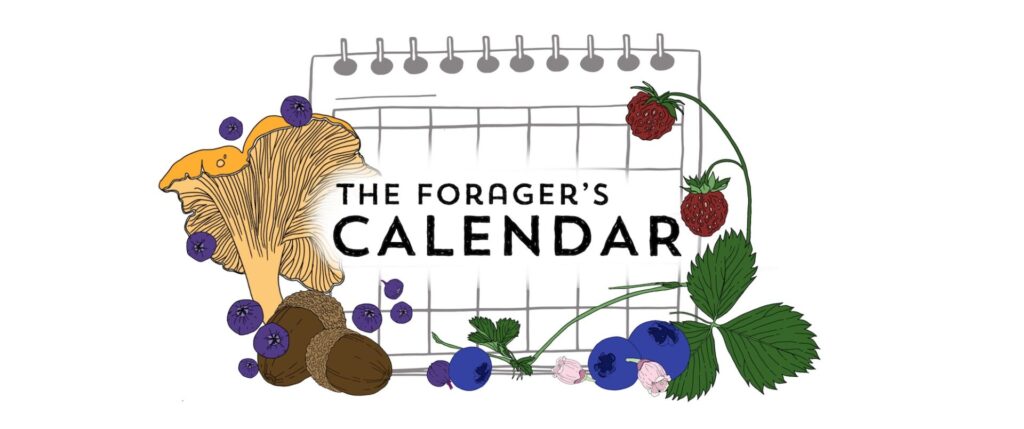
Range
Wild elderberry plants grow all around the world.
- American elderberry are primarily found in Eastern North America
- Blue Elderberry are primarily found in Western North America
- Red Elderberry are found across North America, typically in more northern climates
Then there are European species like Dwarf Elderberry and Black Elderberry.
This article will mainly focus on the North American species, particularly American elderberry, but the uses across most elderberry species are all very similar!
Gathering
Gathering elderberries is simple!
Take care to only harvest ripe clusters of dark purple berries.
Gathering clusters with unripe berries will only make processing more tedious down the line.
You can give a light shake to berry clusters to encourage any bugs hanging out on them to fly away.
Using a knife or clippers, cut off the berry cluster at the base of the stem.
Place your clipped berry clusters into a foraging basket.
Sometimes I use a hook to bring berry clusters closer to me while keeping my hands free.

Processing (How to de-stem elderberries)
This will be one of the most important sections of this article. Many of you may have come across my work looking for efficient ways to process or “de-stem” elderberries.
I’ve laid out all the methods below! (the first is the best)
Freeze method
I have tried many methods of efficiently separating elderberry seeds from the stems, and by far, the “freeze” method is the most efficient.
In addition, the freeze method always allows you to easily use partial amounts of your elderberry harvest for things like syrup, wine, or even dehydrating.
The only con of this method is the need for freezer space.
A good dedicated freezer is a vital investment if you are serious about foraging for wild fruit.
Click here for the one I recommend!
Steps:
- Spread out your elderberries on a solid tray with the stems down and the berries up.
- Place them into a freezer and allow them to completely freeze (at least 6 hours).
- Remove them from the freezer and, with your hands, crush everything into smaller pieces; the berries should easily detach from the stems.
- Use a large colander or mesh filters to sort the berries from the larger stems efficiently.
- Place your frozen elderberries into a freezer bag to use as needed (Optionally dehydrate berries at this stage if you prefer).
Tips:
- Don’t harvest berry clusters with mixed ripeness; this will only make processing more tedious.
- Don’t wash your berries before doing this; it will make subsequent steps more difficult (instead, wash them before you use them for other things).
- Use insulated gloves so your hands don’t heat up the berries and the berries don’t make your hands cold!
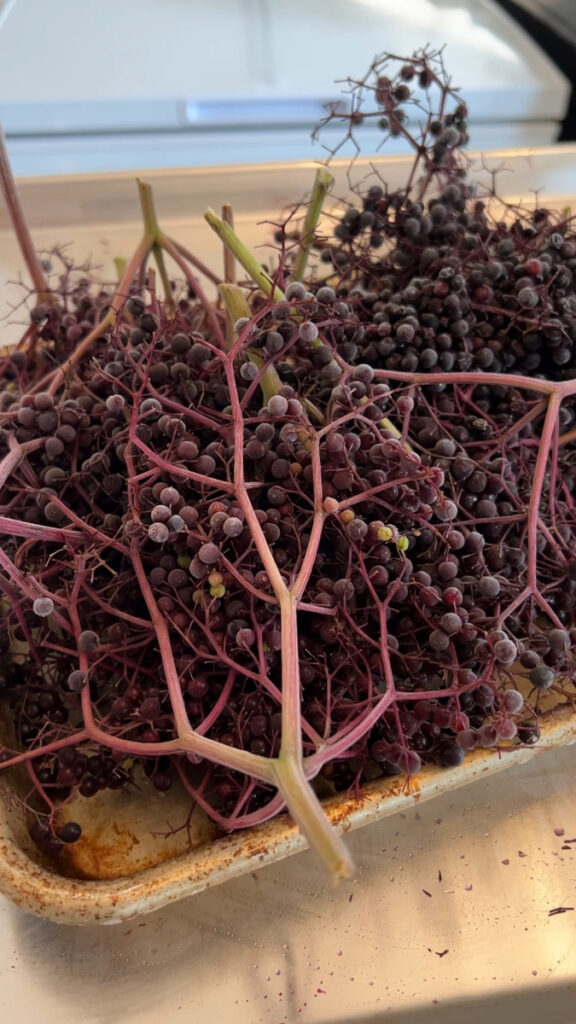
Shake method
If you don’t have access to enough freezer space to conduct the freeze method, you may also try what I call the “shake” method.
This works best with a large soft-shelled cooler.
Steps:
- Take your elderberry clusters and shake them against the walls of a cooler.
- The ripe berries should fall off of the stems without too much trouble.
- Use a filter to sort out any large stems that fall in or manually remove them.
- Place separated berries into a bag to freeze long-term or dehydrate immediately.
Comb method
Another thing you can try if you don’t have freezer space is to use a comb. You’ll want to find a comb with large enough spaced teeth to run through the stems.
Even then, I’ve found this to be mostly messy and inefficient overall.
Preserving
There are two main ways to preserve elderberries for long-term use: freezing and dehydrating. They both work great but have slightly different uses.
Freezing is great if you intend to juice the elderberries in the future (discussed in the Preparations section).
Dehydration has many perks as well.
- You’ll save freezer space.
- It gives elderberries a richer flavor (that many people prefer).
- Doesn’t require any energy to store.
I use a combination of both depending on what I intend to do.
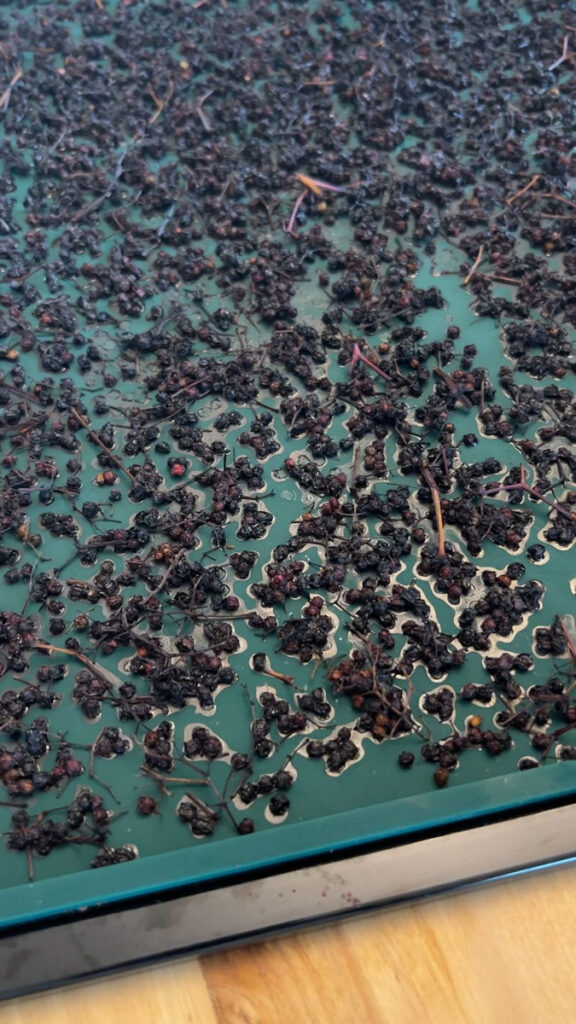
Benefits and uses
Elderberry has a growing reputation for its efficacy and traditional uses against the flu virus.
If you look up elderberry in Native American ethnobotany (Moerman, 2009), you’ll find a myriad of uses.
It was used for the common cold and fevers.
It was used as a food for jelly, pies, syrups, and more!
There is more than just anecdotal evidence and history for this too!
A meta-analysis Black elderberry supplementation effectively treats upper respiratory symptoms (Hawkins et al., 2019) states:
Supplementation with a standardized elderberry extract is significantly effective at reducing the total duration and severity of upper respiratory symptoms, as compared to a placebo group.
Digging further into the Discussion section, we find that elderberry supplementation was found to have significant effects against influenza and lesser but still notable effects against the common cold.
To get more into the nutritional details, Elderberry as a potential source of antioxidants (Dominguez et al., 2020) shows elderberry to be high in beneficial compounds like flavonoids and phenolic acids, contributing to its antioxidant activity.
Edible uses and preparations
Elderberry can be eaten in many different ways!
The most popular preparation of elderberry that you are likely familiar with is elderberry syrup, but in my opinion, there are FAR better options!
A lot of these preparations will start with elderberry juice. Once I discovered how easy and efficient it is to juice elderberries with a steam juicer, I’ve never gone back!
A steam juicer is by far the easiest way to juice your elderberries and comes with the advantage of cooking them in the process, a task that needs to be done anyway!
This is the steam juicer that I use and recommend!
I would love to describe the taste of elderberry to you, but to be honest, I find it hard to compare it to anything other than… elderberry.
Seriously, to me elderberry has a unique taste and aroma that has to be experienced. Some people find it somewhat nauseating, but I find it quite pleasant!
Elderberry wine
I like to make wine with many wild fruits that I forage for. I am by no means a good winemaker, but I make good elderberry wine.
If you are new to fermenting, it is much easier than you may think! I’ll be covering more about this in my Fermenting for Foragers guide!
The best point to start with elderberry wine is the juice from the steam juicer. This will give you a nice, full, concentrated flavor!
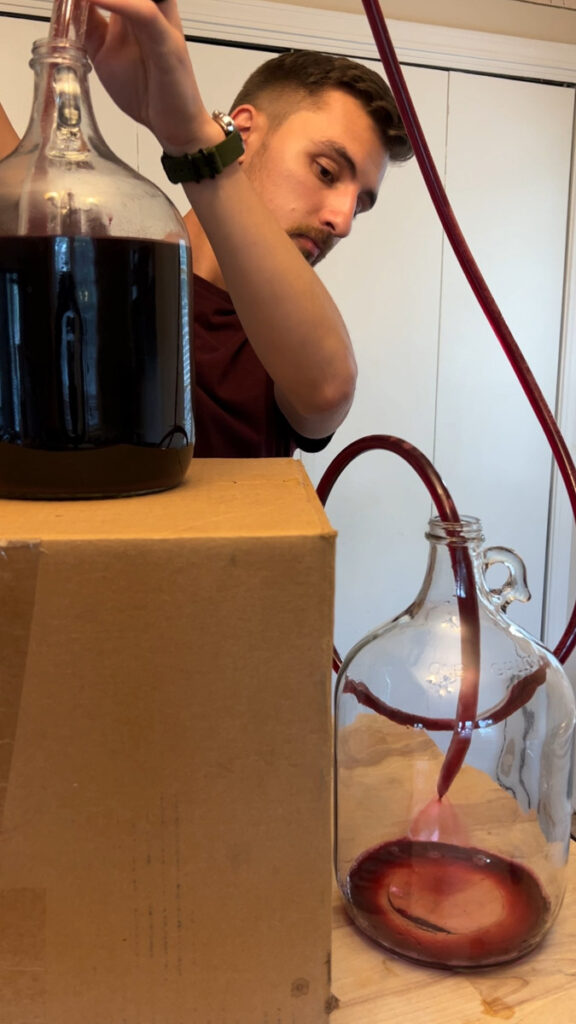
Elderberry tea
Elderberry tea is a personal favorite of mine. This is one that I really prefer to make from the dehydrated berries. If you think you don’t like the flavor of elderberry, you should try this recipe!
Dehydrating the berries adds a richness to their flavor that a lot of people, including myself, really like.
Elderberry syrup
One of the more popular options for cooking with elderberry. Elderberry syrup is great and easy to make!
- Add equal parts sugar to elderberry juice.
- Heat the solution until the sugar has completely dissolved.
- Waterbath can or quick can the syrup for medium to long-term use.
You don’t need to heat the syrup to any particular point or anything like that to get your desired consistency. If you find your syrup too runny, add sugar. If you find it too thick, add juice.
Elderberry jelly
The preparation for elderberry jelly is very similar to that of syrup, except we’ll add a little pectin as well.
There are many different approaches to making jelly, but I would recommend going off of the recommended directions on the pectin packet that you purchase.
Safety and Toxicity
Many people consider elderberry to be “toxic.” You may also hear that wild elderberry is toxic. In my opinion, both of these statements are not true.
Neither cultivated nor wild elderberries are toxic when cooked or prepared properly.
After all, we don’t call potatoes or beans toxic just because they will make you sick if you eat them raw, so why would we do so for elderberry?
You may hear that certain species of elderberry, like Dwarf Elderberry or Red Elderberry, are toxic, which again is not valid! A myriad of anecdotal, traditional, and scientific sources support this.
All members of the elderberry genus Sambucus can be consumed with proper preparation!
Below, we’ll explore the chemistry and background cases surrounding the myth of elderberry toxicity.
Q: Are all elderberries edible?
A: With proper processing, yes, all ripe elderberries (fruits of Sambucus) are edible.
Elderberry and cyanide
Elderberry toxicity is almost always directly associated with the presence of cyanide or cyanogenic glycosides.
However, my theory is that something else is responsible for the symptoms of raw elder consumption.
When someone reports having ill effects from raw elder (and not everyone does), it’s almost always one group of symptoms: major gastrointestinal distress, usually in the form of nausea and vomiting.
If we look at the symptoms associated with acute cyanide poisoning, nausea is one, but there are many others.
So why would raw elderberry consumption consistently yield that one symptom? I hypothesize that it isn’t due to cyanide at all!
Further, looking at various studies on elderberry cyanide content, we found a dramatic variability across different species and populations.
Poisoning cases
A commonly cited toxicology report (and one of the only ones) involved a strange religious group in California that consumed a raw drink of not just elderberries but the leaves and even branches (reportedly).
From everything you’ve read, you should immediately recognize this as ill-informed.
They developed extreme nausea (as expected), and some drank as much as five glasses of the juice.
However, (this is extremely important to note) when taken to the hospital, their serum cyanide levels were NORMAL (Poisoning from Elderberry Juice).
In my extensive research, I have never encountered a case of severe illness arising from elderberry fruit consumption, raw or cooked. (With the caveat that raw consumption is still not recommended)
Identification
Elderberry trees or bushes are relatively easy to recognize if you know what to look for!
Elderberry is sometimes called a tree but is more often growing as a shrub with multiple stems originating at the base.
- Shrub or small tree, typically growing 5-12 feet tall with stems rarely exceeding 3 inches in diameter, with multiple stems growing from the ground for one bush.
- Compound leaves with 5-11 leaflets (usually 7-9), each leaflet lance-shaped to oblong, 2-5 inches long, with serrated edges.
- Bark is light gray to brown, with shallow furrows and distinct darker raised lenticels.
- Large clusters of small, white to cream flowers, forming flat-topped or slightly rounded cymes, blooming in late spring to early summer.
- Fruits are small, dark purple to black berries in large clusters, ripening in late summer to fall.

Winter characteristics
Winter is actually a great time to go scouting for elderberry! Here are easy details to recognize it at that time.
- Bark: Usually gray in color overall, sometimes with a slight purple-red hue. Even the mature bark is covered with raised darker brown spots called “lenticels.” Other than the lenticels, the texture of the bark is smooth.
- Buds: Arranged opposite, buds are overall inconspicuous, usually appearing as a small brown-to-purple bump above the larger leaf scars. Buds of elder typically shoot out very early in the season, even in winter. Without true terminal buds.
- Leaf Scar: Leaf scars are large and somewhat triangular, usually more brown than the twigs or stems. Multiple (3+) bundle scars can be found within them.
- Twigs: Twigs are gray and covered by many darker lenticels. Inside the twig is a distinct white spongy pith.
- Growth Habit: Elderberry has a very “shrubby” growth. Usually with many stems arising from an underground base. Shrubs grow 5-12ft tall, with stems rarely exceeding 3 inches in diameter.
- Remarks: Easily recognized by the many stems clustered at the base and prominent lenticels throughout the maturity of the shrub. Look for plants near water with ample sunlight for best fruiting later in the season.
- Similar Species: Relatively easy to distinguish, I cannot think of another species with an opposite arrangement that could be mistaken for elderberry.
Winter Possible Lookalikes:
- Ash – due to arrangement and lenticels present. Pith, and the presence of a terminal bud easily separate them.
- Sumac – due to similar growth habit and lenticels. Arrangement easily separates them as Rhus has an alternating arrangement.
Lookalikes
There are a few plants that many people mistake for elderberry. Some are easier to distinguish than others. I’ll walk you through each of them and the important characteristics to tell them apart!
Elderberry vs Water Hemlock
Elderberry and water hemlock can look similar due to their blooms and compound leaves, but here are easy ways to tell them apart.
The main time you could mistake them is when they are flowering. They look completely different in their fruit.
- Leaves: Elderberry has single compound (pinnate) leaves with wider leaflets arranged opposite one another. Water hemlock has triple compound (tripinnate) leaves with narrower leaflets arranged alternately. Elderberry leaves are finely serrated, with secondary veins not extending to the valleys between serrations, while water hemlock’s leaves are less finely serrated, and the veins end in the valleys.
- Flowers: Both have 5 petals, but elderberry’s are larger and can appear fused, while water hemlock’s are smaller and clearly separated up close. Elderberry’s filaments are shorter with larger, cream-colored anthers, while water hemlock’s filaments are longer with smaller, beige-colored anthers.
- Stem: Elderberry stems contain a spongy pith material, whereas water hemlock’s stems (except for the youngest parts) are completely hollow. Both may have a dusty bloom on the surface, but water hemlock’s is more prominent. Elderberry also has lenticels present, while water hemlock lacks them.
- Aroma: Elderberry leaves have a pungent, somewhat “off” smell (often described as burnt peanut butter), and its flowers have a sweet, floral aroma. Water hemlock emits a strong “carrot” smell from all parts of the plant.
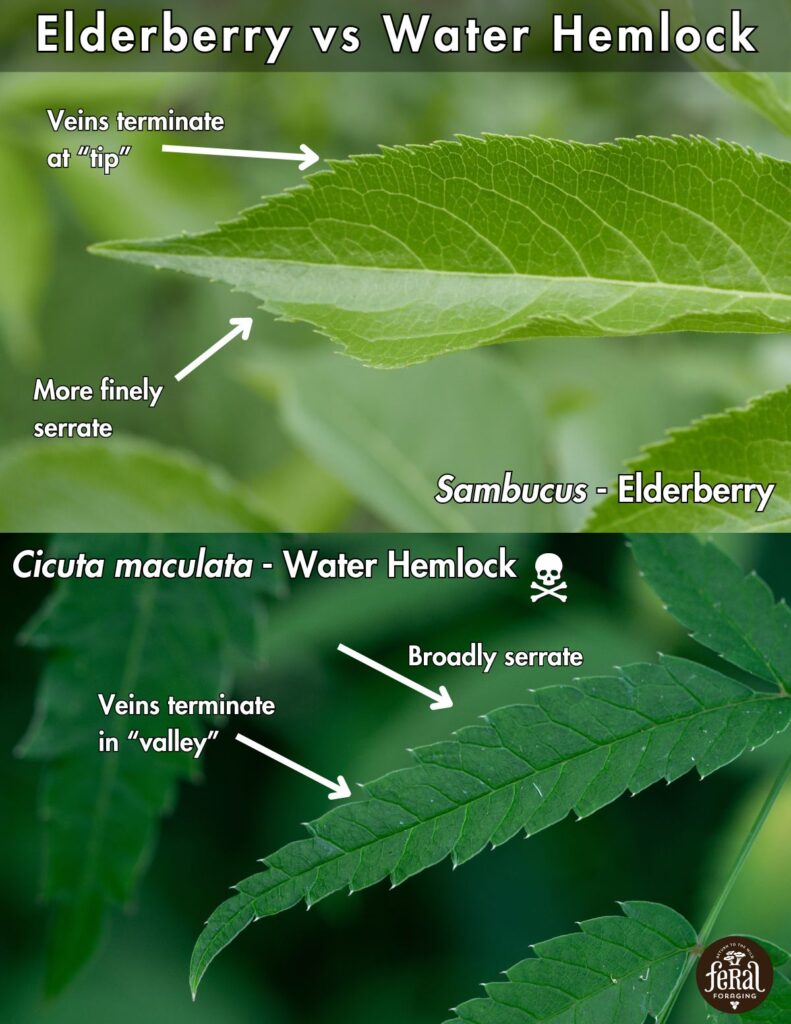
Elderberry vs Pokeweed
Pokeweed berries are commonly confused with elderberry as, individually, they look relatively similar, and they are ripe around the same time.
However, with just a few details, they are extremely easy to distinguish!
- Form: Pokeberries grow in a line called a “raceme” whereas elderberries grow as a broad cluster called a “cyme”.
- Growth: Pokeberry is an herbaceous perennial, so it never has bark vs elderberry which is a woody perennial with bark.
Beyond just the individual berries, pokeweed and elderberry plants are different in just about every way.
They also differ in their leaf type (pokeweed simple vs elderberry compound) and their arrangement (pokeweed alternating vs elderberry opposite).
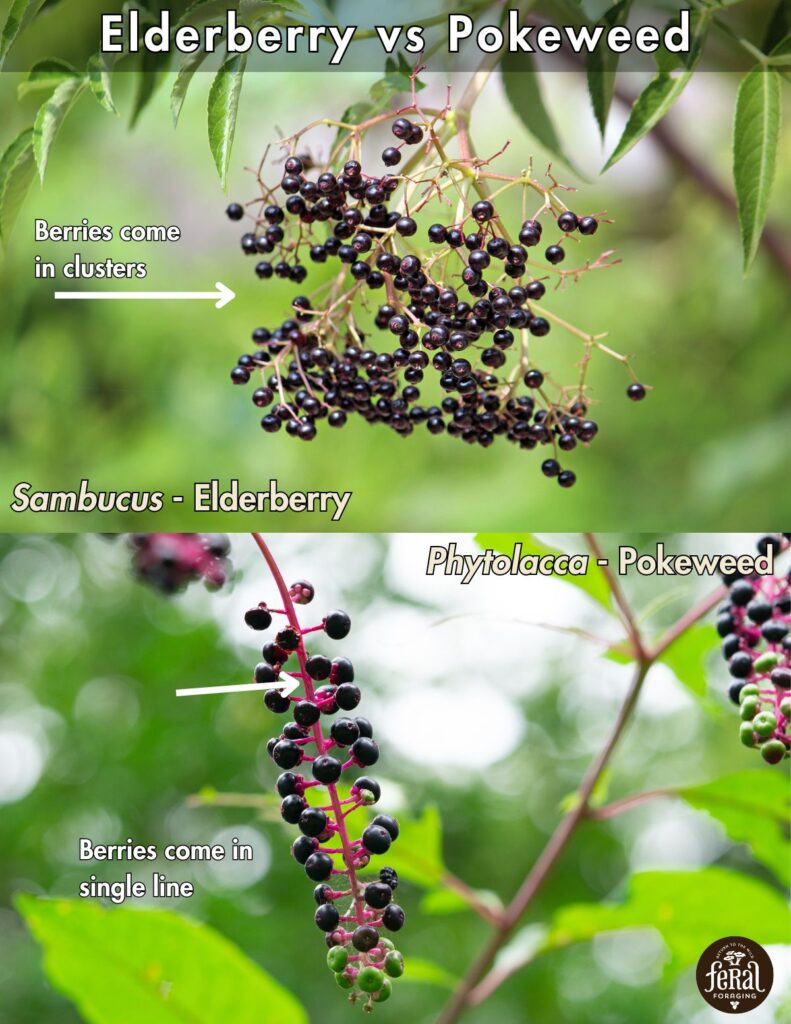
Elderberry vs Devil's Walking Stick
The berries of Devil’s Walking stick look exceedingly similar to elderberries. Here are easy ways to distinguish the plants.
- Leaves: Devil’s walking stick with extremely large triple pinnate compound leaves (often greater than 3 feet in length) with wider leaflets. Elderberry has single pinnate compound leaves and more narrow leaflets. In addition, the leaves (not leaflets) of Devil’s walking stick are arranged alternately whereas with elderberry they are distinctly arranged oppositely.
- Bark: Devil’s walking stick with distinct spines present along the exterior of the bark concentrated around leaf nodes, elderberry lacks these (this is the easiest detail).

Closing Thoughts
While there may be some modern fear mongering around wild elderberries, it is mostly around misunderstandings of the plant and its fruit.
Elderberry is a common wild fruit tree that produces thousands of fruits every year.
It is extremely safe to use with proper processing and carries a ton of benefits along with it as well.
I hope you’ll look out for elderberry the next time you come across one!
